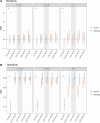Estimating sensitivity and specificity of diagnostic tests using latent class models that account for conditional dependence between tests: a simulation study
- PMID: 36894883
- PMCID: PMC9999546
- DOI: 10.1186/s12874-023-01873-0
Estimating sensitivity and specificity of diagnostic tests using latent class models that account for conditional dependence between tests: a simulation study
Abstract
Background: Latent class models are increasingly used to estimate the sensitivity and specificity of diagnostic tests in the absence of a gold standard, and are commonly fitted using Bayesian methods. These models allow us to account for 'conditional dependence' between two or more diagnostic tests, meaning that the results from tests are correlated even after conditioning on the person's true disease status. The challenge is that it is not always clear to researchers whether conditional dependence exists between tests and whether it exists in all or just some latent classes. Despite the increasingly widespread use of latent class models to estimate diagnostic test accuracy, the impact of the conditional dependence structure chosen on the estimates of sensitivity and specificity remains poorly investigated.
Methods: A simulation study and a reanalysis of a published case study are used to highlight the impact of the conditional dependence structure chosen on estimates of sensitivity and specificity. We describe and implement three latent class random-effect models with differing conditional dependence structures, as well as a conditional independence model and a model that assumes perfect test accuracy. We assess the bias and coverage of each model in estimating sensitivity and specificity across different data generating mechanisms.
Results: The findings highlight that assuming conditional independence between tests within a latent class, where conditional dependence exists, results in biased estimates of sensitivity and specificity and poor coverage. The simulations also reiterate the substantial bias in estimates of sensitivity and specificity when incorrectly assuming a reference test is perfect. The motivating example of tests for Melioidosis highlights these biases in practice with important differences found in estimated test accuracy under different model choices.
Conclusions: We have illustrated that misspecification of the conditional dependence structure leads to biased estimates of sensitivity and specificity when there is a correlation between tests. Due to the minimal loss in precision seen by using a more general model, we recommend accounting for conditional dependence even if researchers are unsure of its presence or it is only expected at minimal levels.
Keywords: Bayesian inference; Conditional dependence; Diagnostic test accuracy; Latent class model.
© 2023. The Author(s).
Conflict of interest statement
The authors declare that they have no competing interests.
Figures


References
-
- Koukounari A, Webster JP, Donnelly CA, Bray BC, Naples J, Bosompem K, et al. Sensitivities and specificities of diagnostic tests and infection prevalence of Schistosoma haematobium estimated from data on adults in villages northwest of Accra, Ghana. Am J Trop Med Hyg. 2009;80(3):435–441. doi: 10.4269/ajtmh.2009.80.435. - DOI - PMC - PubMed
Publication types
MeSH terms
Grants and funding
LinkOut - more resources
Full Text Sources
Medical

